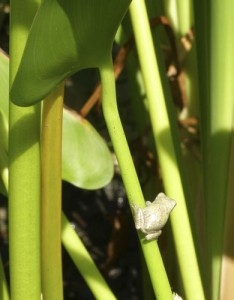Wild encounters on Jones Street
Originally published September 18, 2008

Photo by Ken Moore. Young gray tree frog on pickerelweed stem in Natural Science Museum’s wild garden on Raleigh’s Jones Street
By Ken Moore
Next week, Sep 24-30, is “Take a Child Outside Week,†and the North Carolina Museum of Natural Sciences has planned some specific activities to promote awareness (www.naturalsciences.org).
A visit to the Museum of Natural Sciences in Raleigh begins with awareness on the outside. Along the half-block-long north side of the museum facing Jones Street, there is a wild garden in dramatic contrast to the strictly regimented lawn and shrub monoculture of the North Carolina Legislature across the street.
The museum’s wild garden is by design a loose assemblage of plants representative of the botanical diversity of the state, from the seacoast to the mountains. Many of the plants from far reaches of the state will not survive on the museum’s harsh north bank. Surprisingly, some do, like the native mountain bush honeysuckle, Diervilla sessilfolia, which occurs naturally in only a few places at very high elevations. Not expected to survive along Jones Street, the mountain bush honeysuckle is thriving. I wonder that there may be some similarities between the harshness of the urban site and the high mountain elevations.
That 4,000-square-foot street-side wild garden attracts a great diversity of wild critters. Several species of birds nest there and feast on the variety of seeds, fruits and insects associated with the native plants. Praying mantises hunt atop the massive heads of Joe-Pye weed, Eupatorium fistulosum. Common Buckeye butterflies linger on the flower heads of rattlesnake master, Eryngium yuccifolium.
The foliage of the common milkweed, Asclepias syriaca, provides sustenance for monarch butterfly larva. The foliage of wildflowers and grasses provides suitable sites for the ferocious-looking black-and-yellow garden spider, also called the writing spider because of the heavy silken zigzag script-like pattern in the center of the web. Museum curators frequently visit the wild garden to selectively harvest plant materials to feed some of the critters displayed inside.
An artificial pool near the museum entrance contains a permanent sculpture installation of Rachel Carson exploring a marsh with two young people. Native cattails, Typha latifolia, waterlilies, Nymphaea odorata, and pickerelweed, Pontederia cordata, provide authenticity to the scene. On a recent Sunday while awaiting the opening of the museum, two young brothers from Garner joined Rachel Carson in exploring that little street-side pond. The discovery of tadpoles was immediate, but it took the keen “closer look†of the two boys to discover the skeleton case of a dragonfly nymph left clinging to a pickerelweed stem by the recently emerged airborne adult dragonfly. They proudly shared their discovery with the appreciative adults. Were the boys to return now, they would likely discover that one of those tadpoles has emerged as a tiny grey tree frog living among the tall stems of the pickerelweed. On your next visit to the museum, linger awhile along the edge of the wild garden to search for more nature in action.
Every week should be “Take a Child Outside Week.†If you don’t routinely do it, then begin it now. And don’t forget to take your inner child out with you. Whether in a local nature reserve or passing one of many hidden wild patches in and around town, keen eyes will lead you to beauty and drama. And don’t be surprised if you become inclined to begin a small wild garden of your own.


Comments are closed.